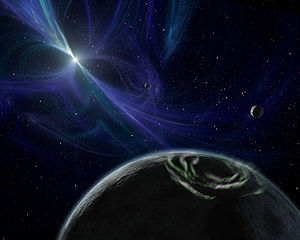- Pulsar-Planet
-
 Eine künstlerische Darstellung des Planetensystems von PSR B1257+12.
Eine künstlerische Darstellung des Planetensystems von PSR B1257+12.
Pulsar-Planeten sind Exoplaneten, die Pulsare oder Neutronensterne umkreisen. Der erste dieser Planeten wurde um einen Millisekundenpulsar entdeckt und war zugleich der erste Exoplanet, der entdeckt wurde. Pulsar-Planeten werden durch die Pulsar-Timing-Methode gefunden, also über Anomalien der Puls-Periode. Alle Himmelskörper, die einen Pulsar umkreisen, verursachen regelmäßige Änderungen der Puls-Periode. Da Pulsare mit einer sehr konstanten Geschwindigkeit rotieren, können Abweichungen relativ einfach mit genauen Messmethoden festgestellt werden.
2006 wurde entdeckt, dass der Pulsar 4U 0142+61, 13.000 Lichtjahre von der Erde entfernt, eine protoplanetare Scheibe besitzt. Die Entdeckung wurde von einem von Deepto Chakrabarty geleiteten Team des Massachusetts Institute of Technology mithilfe des Spitzer-Weltraumteleskops gemacht.[1] Die Scheibe entstand vermutlich aus metallreichen Ablagerungen einer Supernova, die den Pulsar vor ca. 100.000 Jahren formte. Sie ähnelt denen, die um sonnenähnliche Sterne zu finden sind, was vermuten lässt, dass sich auch ähnliche Planeten bilden. Pulsar-Planeten können wahrscheinlich kein Leben beherbergen, wie wir es kennen, weil der hohe Grad ionisierender Strahlung, die der Pulsar abstrahlt, und der dazugehörende Mangel an sichtbarem Licht jede bekannte Form von Leben unmöglich macht.
Inhaltsverzeichnis
Liste bekannter Pulsar-Planeten
Bemerkung: MJ meint die Masse des Jupiter, und ME die Masse der Erde.
Bestätigte Planeten
Pulsar Planet Masse PSR B1620-26 PSR B1620-26c 2.5 MJ PSR B1257+12 PSR B1257+12 A 0.020 ME PSR B1257+12 B 4.3 ME PSR B1257+12 C 3.90 ME PSR B1257+12 D 0.0004 ME Fragliche Planeten
Pulsar Planet Masse Geminga Geminga b 1.7 ME PSR B0329+54 PSR B0329+54 A 0.3 ME PSR B0329+54 B 2.2 ME PSR B1828-10 PSR B1828-10 A 3 ME PSR B1828-10 B 12 ME PSR B1828-10 C 8 ME Proplyds
Pulsar Proplyd 4U 0142+61 4U 0142+61's Proplyd Siehe auch
Quellen
- ↑ Scientists crack mystery of planet formation. CNN.com (5. April 2006). Abgerufen am 5. April 2006.
Wikimedia Foundation.
